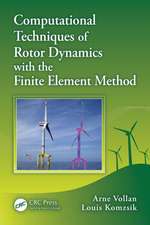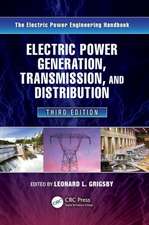Three-phase AC-AC Power Converters Based on Matrix Converter Topology: Matrix-reactance frequency converters concept: Power Systems
Autor Paweł Szcześniaken Limba Engleză Hardback – 20 mar 2013
Three-Phase AC-AC Power Converters Based On Matrix Converter Topology: Matrix-reactance frequency converters concept presents a review of power frequency converters, with special attention paid to converters without DC energy storage. Particular attention is paid to nine new converters named matrix-reactance frequency converters which have been developed by the author and the team of researchers from Institute of Electrical Engineering at the University of Zielona Góra. The topologies of the presented matrix-reactance frequency converters are based on a three-phase unipolar buck-boost matrix-reactance chopper with source or load switches arranged as in a matrix converter. This kind of approach makes it possible to obtain an output voltage greater than the input one (similar to that in amatrix-reactance chopper) and a frequency conversion (similar to that in a matrix converter).
Written for researchers and Ph.D. students working in the field of power electronics converters and drive systems, Three-Phase AC-AC Power Converters Based On Matrix Converter Topology: Matrix-reactance frequency converters concept will also be valuable to power electronics converter designers and users; R&D centers; and readers needing industry solutions in variable speed drive systems, such as automation and aviation.
| Toate formatele și edițiile | Preț | Express |
|---|---|---|
| Paperback (1) | 635.15 lei 6-8 săpt. | |
| SPRINGER LONDON – 7 mar 2015 | 635.15 lei 6-8 săpt. | |
| Hardback (1) | 640.88 lei 6-8 săpt. | |
| SPRINGER LONDON – 20 mar 2013 | 640.88 lei 6-8 săpt. |
Din seria Power Systems
- 18%
 Preț: 953.13 lei
Preț: 953.13 lei - 18%
 Preț: 783.98 lei
Preț: 783.98 lei - 20%
 Preț: 1002.47 lei
Preț: 1002.47 lei - 18%
 Preț: 1021.86 lei
Preț: 1021.86 lei - 18%
 Preț: 897.65 lei
Preț: 897.65 lei - 18%
 Preț: 788.72 lei
Preț: 788.72 lei - 18%
 Preț: 734.27 lei
Preț: 734.27 lei - 18%
 Preț: 902.36 lei
Preț: 902.36 lei -
 Preț: 563.49 lei
Preț: 563.49 lei - 18%
 Preț: 955.08 lei
Preț: 955.08 lei - 18%
 Preț: 946.87 lei
Preț: 946.87 lei - 18%
 Preț: 950.52 lei
Preț: 950.52 lei - 18%
 Preț: 949.23 lei
Preț: 949.23 lei - 15%
 Preț: 641.85 lei
Preț: 641.85 lei - 18%
 Preț: 1116.26 lei
Preț: 1116.26 lei - 18%
 Preț: 961.10 lei
Preț: 961.10 lei - 18%
 Preț: 1386.17 lei
Preț: 1386.17 lei - 15%
 Preț: 639.59 lei
Preț: 639.59 lei - 15%
 Preț: 641.03 lei
Preț: 641.03 lei - 18%
 Preț: 2497.51 lei
Preț: 2497.51 lei - 18%
 Preț: 957.62 lei
Preț: 957.62 lei - 18%
 Preț: 1229.91 lei
Preț: 1229.91 lei - 15%
 Preț: 643.34 lei
Preț: 643.34 lei - 18%
 Preț: 957.09 lei
Preț: 957.09 lei - 18%
 Preț: 1231.47 lei
Preț: 1231.47 lei - 15%
 Preț: 698.30 lei
Preț: 698.30 lei - 18%
 Preț: 953.20 lei
Preț: 953.20 lei - 15%
 Preț: 640.88 lei
Preț: 640.88 lei - 15%
 Preț: 634.18 lei
Preț: 634.18 lei - 18%
 Preț: 955.08 lei
Preț: 955.08 lei - 18%
 Preț: 1241.73 lei
Preț: 1241.73 lei - 18%
 Preț: 952.09 lei
Preț: 952.09 lei - 18%
 Preț: 946.55 lei
Preț: 946.55 lei - 18%
 Preț: 961.86 lei
Preț: 961.86 lei - 18%
 Preț: 944.19 lei
Preț: 944.19 lei - 18%
 Preț: 1110.72 lei
Preț: 1110.72 lei - 15%
 Preț: 642.03 lei
Preț: 642.03 lei - 15%
 Preț: 636.12 lei
Preț: 636.12 lei - 18%
 Preț: 1114.83 lei
Preț: 1114.83 lei - 15%
 Preț: 639.90 lei
Preț: 639.90 lei - 18%
 Preț: 957.32 lei
Preț: 957.32 lei - 18%
 Preț: 1235.57 lei
Preț: 1235.57 lei - 18%
 Preț: 959.19 lei
Preț: 959.19 lei
Preț: 640.88 lei
Preț vechi: 753.97 lei
-15% Nou
Puncte Express: 961
Preț estimativ în valută:
122.69€ • 128.01$ • 102.85£
122.69€ • 128.01$ • 102.85£
Carte tipărită la comandă
Livrare economică 13-27 martie
Preluare comenzi: 021 569.72.76
Specificații
ISBN-13: 9781447148951
ISBN-10: 1447148959
Pagini: 188
Ilustrații: XII, 174 p. 172 illus., 37 illus. in color.
Dimensiuni: 155 x 235 x 16 mm
Greutate: 0.43 kg
Ediția:2013
Editura: SPRINGER LONDON
Colecția Springer
Seria Power Systems
Locul publicării:London, United Kingdom
ISBN-10: 1447148959
Pagini: 188
Ilustrații: XII, 174 p. 172 illus., 37 illus. in color.
Dimensiuni: 155 x 235 x 16 mm
Greutate: 0.43 kg
Ediția:2013
Editura: SPRINGER LONDON
Colecția Springer
Seria Power Systems
Locul publicării:London, United Kingdom
Public țintă
ResearchCuprins
Introduction.- Review of AC-AC frequency converters.- Concept of matrix-reactance frequency converters.- Modeling of matrix-reactance frequency converters.- Property analysis.- Experimental investigation.- Summary.
Notă biografică
Paweł Szcześniak’s research is focused on Power Electronics Converters and their digital control. His experience in the field of power electronic converters is related to design, construction and testing of prototypes of matrix converters and matrix-reactance frequency converters, and has extensive experience in the field of digital control using a digital signal processor (DSP), which was used in the control systems in the designed power converters. In June 2010, Paweł Szcześniak obtained his Ph.D. degree from the Electrical Engineering Department at the University of Zielona Góra, defending a thesis dealing with power electronic converters, entitled: “Analysis and testing matrix-reactance frequency converters” and is now employed as an assistant professor at the Institute of Electrical Engineering at the University of Zielona Góra.
Textul de pe ultima copertă
AC voltage frequency changes is one of the most important functions of solid state power converters. The most desirable features in frequency converters are the ability to generate load voltages with arbitrary amplitude and frequency, sinusoidal currents and voltages waveforms; the possibility of providing unity power factor for any load; and, finally, a simple and compact power circuit. Over the past decades, a number of different frequency converter topologies have appeared in the literature, but only the converters with either a voltage or current DC link are commonly used in industrial applications. Improvements in power semiconductor switches over recent years have resulted in the development of many structures of AC-AC converters without DC electric energy storage. Such converters are an alternative solution for frequently recommended systems with DC energy storage and are characterized by a lower price, smaller size and longer lifetime. Most of the these topologies are based on the structure of the matrix converter.
Three-Phase AC-AC Power Converters Based On Matrix Converter Topology: Matrix-reactance frequency converters concept presents a review of power frequency converters, with special attention paid to converters without DC energy storage. Particular attention is paid to nine new converters named matrix-reactance frequency converters which have been developed by the author and the team of researchers from Institute of Electrical Engineering at the University of Zielona Góra. The topologies of the presented matrix-reactance frequency converters are based on a three-phase unipolar buck-boost matrix-reactance chopper with source or load switches arranged as in a matrix converter. This kind of approach makes it possible to obtain an output voltage greater than the input one (similar to that in a matrix-reactance chopper) and a frequency conversion (similar to that in a matrix converter).
Written forresearchers and Ph.D. students working in the field of power electronics converters and drive systems, Three-Phase AC-AC Power Converters Based On Matrix Converter Topology: Matrix-reactance frequency converters concept will also be valuable to power electronics converter designers and users; R&D centers; and readers needing industry solutions in variable speed drive systems, such as automation and aviation.
Three-Phase AC-AC Power Converters Based On Matrix Converter Topology: Matrix-reactance frequency converters concept presents a review of power frequency converters, with special attention paid to converters without DC energy storage. Particular attention is paid to nine new converters named matrix-reactance frequency converters which have been developed by the author and the team of researchers from Institute of Electrical Engineering at the University of Zielona Góra. The topologies of the presented matrix-reactance frequency converters are based on a three-phase unipolar buck-boost matrix-reactance chopper with source or load switches arranged as in a matrix converter. This kind of approach makes it possible to obtain an output voltage greater than the input one (similar to that in a matrix-reactance chopper) and a frequency conversion (similar to that in a matrix converter).
Written forresearchers and Ph.D. students working in the field of power electronics converters and drive systems, Three-Phase AC-AC Power Converters Based On Matrix Converter Topology: Matrix-reactance frequency converters concept will also be valuable to power electronics converter designers and users; R&D centers; and readers needing industry solutions in variable speed drive systems, such as automation and aviation.
Caracteristici
Presents a review of power frequency converters, with special attention paid to converters without DC energy storage Discusses the new converters named matrix-reactance frequency converters which have been developed by the author Includes the modeling and broad analysis (analytical, simulation and experimental) of properties of the proposed matrix-reactance frequency converters Includes supplementary material: sn.pub/extras














